The Outback
From the moment I made my decision to live in Australia I dreamt of sleeping in the Outback. Finally I was on the plane. I was flying from Sydney to Alice Springs. It takes about the same amount of time to fly from New York to St. Louis. That is the only thing that is comparable to the US. I looked out my window and all I could see for miles was red Outback with speckles of green vegetation. There were no roads, cars, houses... I was flying into the heart of Australia.
Walking off the plane is like walking into a dry oven. The sun is sweltering, I had to slow my breathing to allow the thick air into my lungs. It’s a 45 minute drive from the airport into the city of Alice Springs. From my window I observed the aborigines huddled in groups of 2’s, 4’s and more walking about. Some were naked, some in western clothing, wading in small streams and thirsty lakes. It was the first time I had seen aborigines since I had arrived in Australia. I had asked a lot of questions about their culture in the city, but no one seems to want to talk about them. It was as if the government wanted to forget they existed.
Once I checked myself into my hostel I made my way to the town square. There were few tourists and many aborigines. The children were dark skinned with wide noses, dark eyes, and blonde hair. Most of the men were large and wide shouldered. They seemed to be a tight community completely ignoring the Australians and tourists. It was as if no one else existed. As if we were living in a different matrix. When Captain Cook sailed into Botany Bay he saw aborigines for the first time fishing and cleaning clothes in the ocean. Even though his huge sailboat passed right before them ~ a piece of machinery they had never seen before ~ none of them gave the ship a second glance...and hardly even a first glance. I understood that now.
The town square is lined with shops and galleries displaying Anangu (Aboriginal people of western desert) art and crafts. The most interesting being the dot drawings. They are always in earth tones and are images of 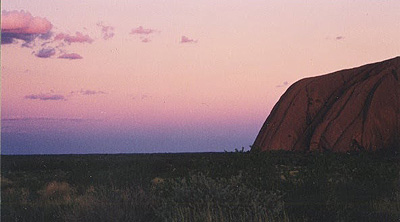 their ancestors’ stories. The crafts were boomerangs (kali), hunting spears (Kulata), Shields (Tjara), bowls and desert animals carved out of wood. The opal stores are also quite popular. Opal mining is a big business in the outback and most shop owners take great pride in explaining the mining process and the differences between high end and low end opals. I felt bad not purchasing an opal or art, but as a backpacker I had little room and less money.
their ancestors’ stories. The crafts were boomerangs (kali), hunting spears (Kulata), Shields (Tjara), bowls and desert animals carved out of wood. The opal stores are also quite popular. Opal mining is a big business in the outback and most shop owners take great pride in explaining the mining process and the differences between high end and low end opals. I felt bad not purchasing an opal or art, but as a backpacker I had little room and less money.
 Around dinner time, a thunderstorm had moved through the city. The storm made me feel even more remote. I could see the lightening stretch from the clouds all the way to the ground. It was a beautiful light show. I just stood outside letting the rain and warm breeze cool me off. I hadn’t stopped sweating since I stepped off the plane and the humidity, once the storm had passed, would make the temperature even more unbearable.
Around dinner time, a thunderstorm had moved through the city. The storm made me feel even more remote. I could see the lightening stretch from the clouds all the way to the ground. It was a beautiful light show. I just stood outside letting the rain and warm breeze cool me off. I hadn’t stopped sweating since I stepped off the plane and the humidity, once the storm had passed, would make the temperature even more unbearable.
I met a travel friend for dinner at the Red Ochre Grill. Of course, we had to try the native food. We ordered and ate smoked kangaroo (a bit gamey), Emu Pate (not a huge fan of pate), Crocodile and Camel kebabs (taste like chicken) and North Indian Xacuti Barramundi Curry. We washed it all down with a bottle of wine from Adelaide. We were full and proud of ourselves for expanding our taste buds. At 5:00 the town was dead, so we headed back to the hostile to pack and prepare for our outback adventure.
We were picked up in an army green 4 WD Land cruiser that seats 13 passengers. It’s neither comfortable nor uncomfortable. The back seat makes for a bumpy ride so the rule was to rotate. We stopped at the top of Anzac Hill and watched the sun rise over Alice Springs. The only word I can use to explain the outback from the view on top of the Hill is vast. Alice Spring looked like an insignificant dot surrounded by so much red dirt.
We then drove south to Erldunda traveling through the Waterhouse and James Ranges with a stop at The Camel Farm. Camels are not indigenous to Australia. They were imported for their ability to survive in the harsh outback conditions and to make it easier for people to travel across the land. I paid a dollar to ride one. I can not imagine riding a camel for longer then the 15 minutes I was on mine. They are not the most graceful of animals and the process of getting on and off makes it hard for anyone with a fear of heights. When my ride was over, my camel burger was done. It was delicious. It tasted like bratwurst.
 After many hours and miles on the road with only the sights of scattered trees and kangaroo carcasses, it’s a celebration to see the faint outline of Uluru in the distance. It was another hour before we would actually arrive at the base of this massive rock. It was 110 degrees when we stepped out of the Land cruiser. There wasn’t another person in sight except for the 13 of us. All we could hear was the wind.
After many hours and miles on the road with only the sights of scattered trees and kangaroo carcasses, it’s a celebration to see the faint outline of Uluru in the distance. It was another hour before we would actually arrive at the base of this massive rock. It was 110 degrees when we stepped out of the Land cruiser. There wasn’t another person in sight except for the 13 of us. All we could hear was the wind.
Uluru (also known as Ayers Rock) sits in Kata Tjuta National Park. There has always been a debate on whether or not people should be able to climb the rock. It is a sacred aboriginal sight and it is said that aborigines prefer people not to climb. But, others believe it is the tourism department that came up with the aborigines’ stance. The Tourism Department wants tourists' revenues but not the liability of climbers. Yet, they were afraid if they told people they weren't allowed to climb, no one would want to visit. Allowing the climb to stay open, but putting a moral question into the equation, limits the number of people who actually climb once they arrive.
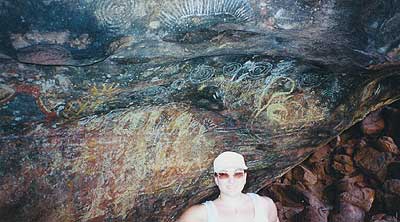 The climb was closed when we arrived. It closes when it's too windy, too rainy, or too hot. 110 degrees was too hot. I grabbed my camera and two bottles of water and started to walk. The angles of the rock looked majestic with the sun shining from behind them. There were caves with aboriginal drawings that date so far back scientists are unable to determine how old they really are. Each crevice, cave, and natural picture on the rock has an aboriginal dream story to explain its existence. On the south side of the rock, a small lake surrounded by lush bushes and birds taunted us. But, we couldn't swim. The lake is considered sacred. It was nice to have this experience to ourselves… except for the pesky bush flies.
The climb was closed when we arrived. It closes when it's too windy, too rainy, or too hot. 110 degrees was too hot. I grabbed my camera and two bottles of water and started to walk. The angles of the rock looked majestic with the sun shining from behind them. There were caves with aboriginal drawings that date so far back scientists are unable to determine how old they really are. Each crevice, cave, and natural picture on the rock has an aboriginal dream story to explain its existence. On the south side of the rock, a small lake surrounded by lush bushes and birds taunted us. But, we couldn't swim. The lake is considered sacred. It was nice to have this experience to ourselves… except for the pesky bush flies.
The bush flies are the most annoying insects I’ve ever encountered. They actually land on your glasses, fly up your nose, and in your eyes and ears. Even when you swat your hand past their backs they don’t move. You have to pick them up and throw them on the ground. I actually inhaled one. I attempted to cough it up – a sad sight – but at the end it ended up in my stomach. The buzzing, however, is enough to drive you mental if the heat doesn’t get to you first. I felt like a walking corpse.
It took me 2 hours to walk completely around Uluru. The temperature had fallen to 98 degrees. I didn’t notice
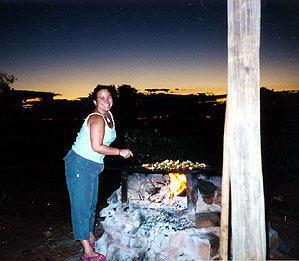
a difference. My clothes were wet with sweat and red with dirt and I had been out of water for the last 30 minutes. I hadn’t talked to anyone for the last hour and I felt inspired. I felt like I knew myself a little better. I was sad that it was over. I had definitely experienced much more by not climbing. The real thing about Uluru is listening to everything around you. It is only then that you truly understand how sacred this rock really is.
Steve, our guide, drove us 20 minutes away from the base to a place that claimed to be the best viewing area of the sunset. There are only 4 minutes in the AM and 4 minutes in the PM to capture the color the world sees in postcards. As you observe, it is easy to see the moment come and go. The entire rock lights up as if it’s on fire. We stood in awe after the color had finally faded. Not really believing what we had just seen.
We arrived at camp soon after the sun set. It consisted of a tin roof held up by four wooden posts, a picnic table, and a sink with drinkable water. We prepared pasta and garlic bread cooked over an open fire.
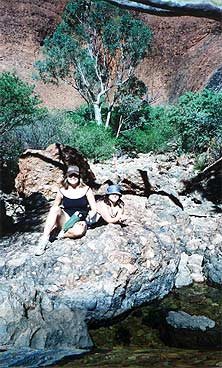 I slept in a sleep sheet tucked into my swag. A swag is basically a sleeping bag with more endurance. I was feeling brave and decided to position my swag on the outskirts of the camp sight. When the fire finally died down the stars were endless. I lay there staring up at the Southern Cross, Orion’s Belt, and the Milky Way. This is what Steve had meant by our campsite being not a "five star hotel" but a "billion star campsite". There was nothing but swag between me and nature. I could hear the wind swirling in circles somewhere close by. I slept with my head, shoulders, and arms outside of my swag. It was morning when I heard that a dingo had circled our campsite at 3 AM. I was bummed that I had missed it!
I slept in a sleep sheet tucked into my swag. A swag is basically a sleeping bag with more endurance. I was feeling brave and decided to position my swag on the outskirts of the camp sight. When the fire finally died down the stars were endless. I lay there staring up at the Southern Cross, Orion’s Belt, and the Milky Way. This is what Steve had meant by our campsite being not a "five star hotel" but a "billion star campsite". There was nothing but swag between me and nature. I could hear the wind swirling in circles somewhere close by. I slept with my head, shoulders, and arms outside of my swag. It was morning when I heard that a dingo had circled our campsite at 3 AM. I was bummed that I had missed it!
I watched the sun rise over Uluru and then we went to The Olga’s. It would be a shame to visit the Outback and stop after Ayers Rock. Olga’s is far more impressive. There is a 1 ½ hour hike hike into the gut of this mountain to "The Valley of the Winds" which leads to "Look Out Peak". I found the rock chalk the aborigines used to paint. We made warrior marks on our arms. My only request was to make me a higher rank than my travel partner. We picked lemon grass and spotted a baby dragon. We saw prickly needles of a tree that aborigines use to heal warts. We saw a dead dried up frog that didn’t make it underground fast enough to hide from the harsh sun. I ate a bush plum. I broke away from the pack and let myself believe I was a pioneer, discovering things for the first time. The terrain was rugged. Some parts were heaps of broken rock that must have fallen from a mountain that had once existed, creating a 4th mountain to the standing three.
We set up camp closer to Kings Canyon. It was 15 miles from the main house of a camel farm. We had a single toilet and a few feet from that was a shower with no door or roof. It was there where I took the most beautiful shower. The sun had just started to set and the sky was a bright pink. Then the sun hit the George Gill Range behind me and lit it up to bright burnt red. It was magical. And I was naked in the wilderness enjoying it all while a camel strolled by. Out here I have no recollection of worries or even the present condition of my life. It is hard to think of anything except what is right in front of you ~ nature. It is surreal.
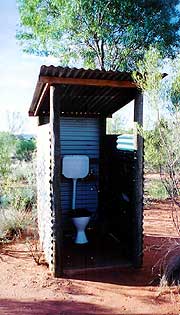 The next day we packed up and headed to King’s Canyon (Watarrka). It begins with a six mile hike mostly at an incline. I lead the pack as I love seeing only the land in front of me. The formations were huge and round. The desert wind swirls in circles causing the large rock masses to take on a more rounded shape. Unlike Uluru and The Olga’s, there is life on this mountain. The rain water seeps through the first layer of sand until it hits the mud. Since it can't penetrate through the mud, the rain water waits to be absorbed by the eucalyptus tree or spinnifex. The most exotic tree to see in the outback is the MacDonald Palm Tree. It looks like a palm tree and has been around since the dinosaurs. We also found a fossil that we decided dated back to the ice age.
The next day we packed up and headed to King’s Canyon (Watarrka). It begins with a six mile hike mostly at an incline. I lead the pack as I love seeing only the land in front of me. The formations were huge and round. The desert wind swirls in circles causing the large rock masses to take on a more rounded shape. Unlike Uluru and The Olga’s, there is life on this mountain. The rain water seeps through the first layer of sand until it hits the mud. Since it can't penetrate through the mud, the rain water waits to be absorbed by the eucalyptus tree or spinnifex. The most exotic tree to see in the outback is the MacDonald Palm Tree. It looks like a palm tree and has been around since the dinosaurs. We also found a fossil that we decided dated back to the ice age.
When we finally made it too the top the view was spectacular. I laid on the ground and stuck my head out over the canyon. The way it is cut away on the inside is exquisite, and at the bottom I saw a patch of green. It is the Garden of Eden. We spent a half hour resting and enjoying the view, then we headed down into the heart of the canyon. Tucked in the canyon, the Garden of Eden is the home to bush birds, trees, plants, and a large cools spring. It's an oasis in the middle of the rugged country. There was no hesitation... we all jumped in. It was, after all, the Garden of Eden, and when we finally dried off our guide handed us each an apple.
We were exhausted at the end of our hike. We spent the night at another camel farm. We had a big meal and Australian beer. Our group was quite diverse. France, England, New Zealand, Ireland, Australia, US and Holland were all represented. We took turns singing our National Anthems and trying to teach each other the words. Fortunately, our neighbors were miles away.
The final six hours back to Alice Springs was bumpy and hot. I watched the outback pass by; a free range cow as big as a buffalo, wild horses, an emu, and miles and miles of red dirt and bush life. I even saw a kangaroo with a joey peaking out of her pouch. It was like witnessing a little miracle.
This trip into the outback was an unexpected spiritual journey. I didn't want to leave. I had spent the last couple of days meditating surrounded by nature. Nothing else seemed to be important. I didn't need anything. My mind was clear and I didn't want to be disturbed. I felt distant from everyone and everything yet aware. I left the outback a different person than when I arrived. When a journey has this type of impact on you, you have to pass it on. The outback will stay with me for a long time.


